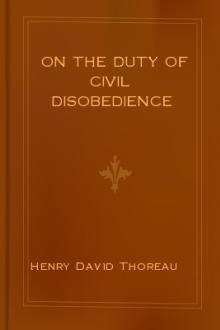Essays - Henry David Thoreau (best e reader for android .TXT) 📗

- Author: Henry David Thoreau
Book online «Essays - Henry David Thoreau (best e reader for android .TXT) 📗». Author Henry David Thoreau
This foliate structure is common to the coral and the plumage of birds, and to how large a part of animate and inanimate nature. The same independence of law on matter is observable in many other instances, as in the natural rhymes, when some animal form, color, or odor, has its counterpart in some vegetable. As, indeed, all rhymes imply an eternal melody, independent of any particular sense.
As confirmation of the fact, that vegetation is but a kind of crystallization, everyone may observe how, upon the edge of the melting frost on the window, the needle-shaped particles are bundled together so as to resemble fields waving with grain, or shocks rising here and there from the stubble; on one side the vegetation of the torrid zone, high-towering palms and widespread banyans, such as are seen in pictures of oriental scenery; on the other, arctic pines stiff frozen, with downcast branches.
Vegetation has been made the type of all growth; but as in crystals the law is more obvious, their material being more simple, and for the most part more transient and fleeting, would it not be as philosophical as convenient to consider all growth, all filling up within the limits of nature, but a crystallization more or less rapid?
On this occasion, in the side of the high bank of the river, wherever the water or other cause had formed a cavity, its throat and outer edge, like the entrance to a citadel, bristled with a glistening ice-armor. In one place you might see minute ostrich-feathers, which seemed the waving plumes of the warriors filing into the fortress; in another, the glancing, fan-shaped banners of the Lilliputian host; and in another, the needle-shaped particles collected into bundles, resembling the plumes of the pine, might pass for a phalanx of spears. From the under side of the ice in the brooks, where there was a thicker ice below, depended a mass of crystallization, four or five inches deep, in the form of prisms, with their lower ends open, which, when the ice was laid on its smooth side, resembled the roofs and steeples of a Gothic city, or the vessels of a crowded haven under a press of canvas. The very mud in the road, where the ice had melted, was crystallized with deep rectilinear fissures, and the crystalline masses in the sides of the ruts resembled exactly asbestos in the disposition of their needles. Around the roots of the stubble and flower-stalks, the frost was gathered into the form of irregular conical shells, or fairy rings. In some places the ice-crystals were lying upon granite rocks, directly over crystals of quartz, the frost-work of a longer night, crystals of a longer period, but to some eye unprejudiced by the short term of human life, melting as fast as the former.
In the Report on the Invertebrate Animals, this singular fact is recorded, which teaches us to put a new value on time and space. “The distribution of the marine shells is well worthy of notice as a geological fact. Cape Cod, the right arm of the Commonwealth, reaches out into the ocean, some fifty or sixty miles. It is nowhere many miles wide; but this narrow point of land has hitherto proved a barrier to the migrations of many species of Mollusca. Several genera and numerous species, which are separated by the intervention of only a few miles of land, are effectually prevented from mingling by the Cape, and do not pass from one side to the other. … Of the one hundred and ninety-seven marine species, eighty-three do not pass to the south shore, and fifty are not found on the north shore of the Cape.”
That common muscle, the Unio complanalus, or more properly fluviatilis, left in the spring by the muskrat upon rocks and stumps, appears to have been an important article of food with the Indians. In one place, where they are said to have feasted, they are found in large quantities, at an elevation of thirty feet above the river, filling the soil to the depth of a foot, and mingled with ashes and Indian remains.
The works we have placed at the head of our chapter, with as much license, as the preacher selects his text, are such as imply more labor than enthusiasm. The state wanted complete catalogues of its natural riches, with such additional facts merely as would be directly useful.
The reports on fishes, reptiles, insects, and invertebrate animals, however, indicate labor and research, and have a value independent of the object of the legislature.
Those on herbaceous plants and birds cannot be of much value, as long as Bigelow and Nuttall are accessible. They serve but to indicate, with more or less exactness, what species are found in the state. We detect several errors ourselves, and a more practised eye would no doubt expand the list.
The quadrupeds deserved a more final and instructive report than they have obtained.
These volumes deal much in measurements and minute descriptions, not interesting to the general reader, with only here and there a colored sentence to allure him, like those plants growing in dark forests, which bear only leaves without blossoms. But the ground was comparatively unbroken, and we will not complain of the pioneer, if he raises no flowers with his first crop. Let us not underrate the value of a fact; it will one day flower in a truth. It is astonishing how few facts of importance are added in a century to the natural history of any animal. The natural history of man himself is





Comments (0)